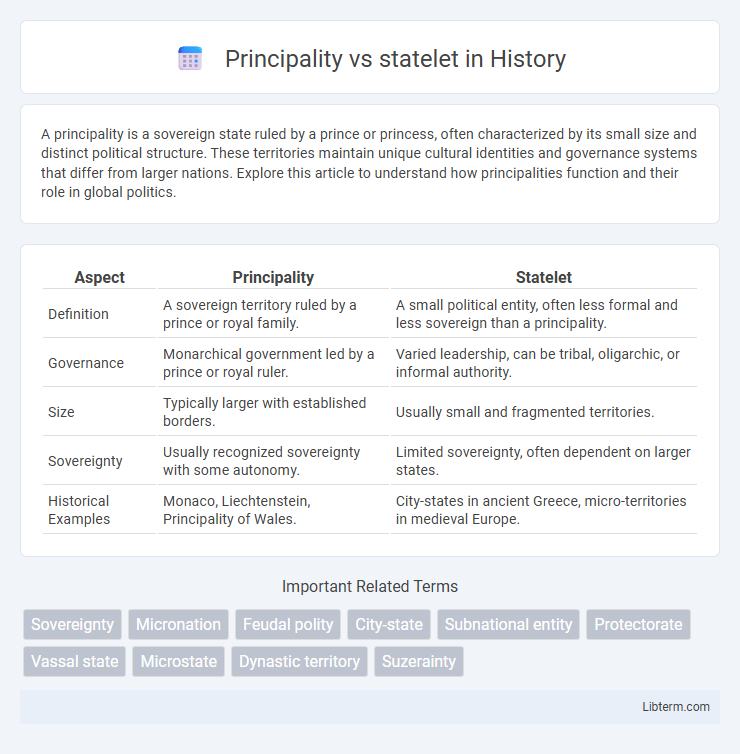A principality is a sovereign state ruled by a prince or princess, often characterized by its small size and distinct political structure. These territories maintain unique cultural identities and governance systems that differ from larger nations. Explore this article to understand how principalities function and their role in global politics.
Table of Comparison
| Aspect | Principality | Statelet |
|---|---|---|
| Definition | A sovereign territory ruled by a prince or royal family. | A small political entity, often less formal and less sovereign than a principality. |
| Governance | Monarchical government led by a prince or royal ruler. | Varied leadership, can be tribal, oligarchic, or informal authority. |
| Size | Typically larger with established borders. | Usually small and fragmented territories. |
| Sovereignty | Usually recognized sovereignty with some autonomy. | Limited sovereignty, often dependent on larger states. |
| Historical Examples | Monaco, Liechtenstein, Principality of Wales. | City-states in ancient Greece, micro-territories in medieval Europe. |
Understanding Principalities: Definition and Origins
Principalities are sovereign territories ruled by a prince or princess, characterized by their historical emergence from feudal systems and dynastic inheritance. Unlike statelets, which are typically smaller and less politically established, principalities possess recognized governance structures and diplomatic relations. Their origins trace back to medieval Europe, where they functioned as semi-autonomous regions under the Holy Roman Empire or other monarchies.
What Is a Statelet? A Modern Perspective
A statelet is a small, autonomous political entity with limited sovereignty and often restricted territorial control, distinguishable from larger states by its minimal governance structures and influence. Unlike principality, which typically refers to a territory ruled by a prince with a clear hereditary leadership, statelets may emerge from fragmented states or conflict zones, displaying flexible and informal political organization. Modern perspectives emphasize statelets as unique actors in geopolitical landscapes, highlighting their roles in regional autonomy, ethnic identity, and localized governance.
Key Historical Examples of Principalities
Key historical examples of principalities include the Principality of Monaco, known for its long-standing sovereignty and influence in European politics, and the Principality of Liechtenstein, which maintains full independence despite its small size. The Principality of Transylvania played a significant role during the Ottoman and Habsburg empires as a semi-autonomous region. Unlike statelets, principalities often had recognized rulers with hereditary titles and established governance structures, granting them greater political stability and diplomatic legitimacy.
Statelets in Contemporary International Relations
Statelets in contemporary international relations are small, often semi-autonomous political entities with limited sovereignty compared to recognized states or principalities. These entities typically possess restricted diplomatic recognition and limited control over external affairs but maintain internal governance structures and cultural distinctiveness. Their existence challenges traditional notions of statehood, influencing international diplomacy, conflict resolution, and regional stability.
Differences in Governance: Principality vs. Statelet
A principality is typically governed by a hereditary prince who holds significant sovereign authority, often with structured administrative institutions and international recognition. A statelet, in contrast, is a smaller political entity with limited governance structures, often lacking full sovereignty or widespread diplomatic acknowledgment. The principality usually exercises centralized control and codified laws, while a statelet may rely on informal leadership and fragmented power systems.
Legal Status and Recognition Worldwide
A principality is a recognized sovereign entity with defined legal status under international law, often ruled by a prince and possessing diplomatic relations, whereas a statelet typically lacks full sovereignty and widespread international recognition. Legal recognition of principalities allows them to participate in treaties and international organizations, while statelets often struggle to achieve legitimacy and are considered dependent or quasi-independent territories. The distinction significantly impacts their ability to engage in global diplomacy, enforce laws, and maintain territorial integrity.
Size, Population, and Economic Implications
A principality typically encompasses a larger territory and population than a statelet, enabling more robust economic activities and infrastructure development. Statelets, often small and limited in resources, face constraints in generating significant economic output due to their minimal size and lower population density. The scale difference impacts tax revenue, public service delivery, and the potential for attracting investment and trade partnerships.
Political Influence and Diplomatic Roles
A principality typically wields greater political influence than a statelet due to its more established governance structures and historical recognition as a sovereign entity. Principalities often engage in formal diplomatic roles, including treaty-making and participation in international organizations, whereas statelets may have limited or informal diplomatic presence confined to regional interactions. The scale and scope of a principality's political power enable it to influence broader geopolitical dynamics compared to the localized authority of a statelet.
Societal and Cultural Distinctions
Principality and statelet differ significantly in societal and cultural distinctions, with principalities often exhibiting established noble hierarchies, governance traditions, and rich cultural heritages rooted in monarchy or aristocracy. Statelets typically possess less complex social structures, smaller populations, and more localized cultural identities that may lack widespread influence or formalized institutions. The societal cohesion in principalities is reinforced by longstanding historical narratives and centralized authority, whereas statelets often maintain diverse, community-driven customs and fluid social organization.
The Future of Principalities and Statelets in Global Politics
Principalities and statelets face increasing challenges as global politics gravitates towards larger nation-states and supranational organizations. The future of principalities depends on their ability to leverage unique economic niches, cultural heritage, and diplomatic agility to maintain relevance. Some statelets may evolve through strategic alliances or integration into regional blocs to sustain political influence amid globalization pressures.
Principality Infographic

 libterm.com
libterm.com